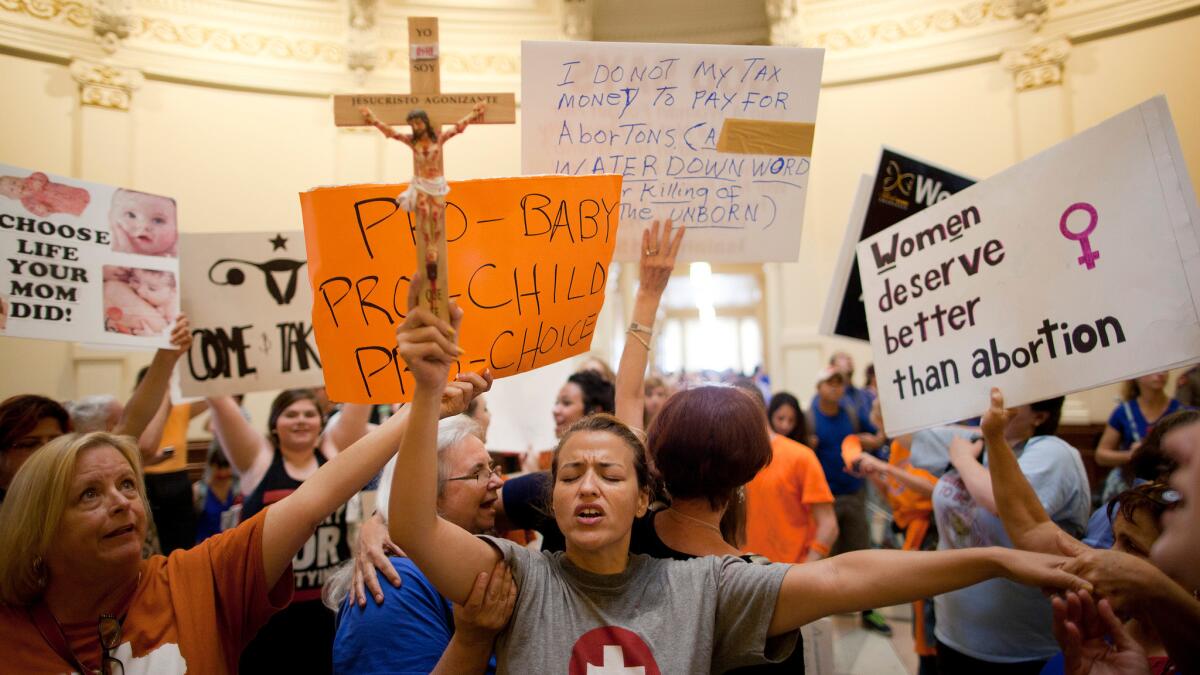Op-Ed: The source of America’s political polarization? It’s us

- Share via
Gun control, abortion, fracking, climate change, immigration, school vouchers, healthcare — the list of issues that Americans are at one another’s throats about seems endless. Who can use which bathroom is now a federal case. It is us-versus-them politics, and it is always the same us and always the same them.
Even those who enjoy a spirited argument suffer from polarization fatigue. But there is no relief coming. Americans are highly polarized and have grown more so. We may blame politicians, big donors, activists or the ideological media for this — but they are just intermediaries. They are not the source of polarization.
We are.
Since 1972, surveys have collected data on how Americans self-identify as liberal, moderate or conservative. I distilled the general ideology data from five polls — the American National Election Studies, the General Social Survey, Gallup, the CBS/New York Times surveys and the national exit polls — to determine just how polarized Americans are and how much more polarized they have become since the 1970s.
About half of the public had chosen a side as a liberal or a conservative by 1972, and half considered themselves moderates (or were unaware of their ideology) — so the nation already was somewhat polarized. By 2015, the split was 56% to 44%, with liberals and conservatives combining to outnumber moderates. A national shift of this size is significant.
This shift seems even larger because ideologies now are more clearly reflected by the political parties. As late as the 1980s, there still were a fair number of liberal Republicans and conservative Democrats. Because the coalitions of both parties were so diverse, neither end of the spectrum was well-represented. The parties, in effect, masked and muted the general public’s polarization.
As the parties realigned over several decades, liberals gravitated to the Democrats and conservatives settled in with the GOP. According to election exit polls, the share of the Democratic vote coming from liberals increased from 26% in 1980 to 43% in 2012. The Republican vote drawn from conservatives increased from 39% to 60% over the same period. That makes both parties much more dependent on their ideological wings for support — in votes and contributions. The polarized perspectives of the public are now firmly embedded in the parties.
Deep polarization is a fact of American political life in the 21st century, but our debates need not stay so overheated.
None of this will change soon. Even demographic shifts (the passing of generations and the growing proportion of non-whites among U.S. voters) may move the center point a bit left, but it won’t narrow the gap between ideological partisans.
Still, conflict doesn’t have to stay at a constant boil; the heat can be turned up or down by circumstances. Americans can be brought together by shared crises, as they were during the Great Depression and World War II, and briefly after 9/11, as well as by widely shared periods of prosperity, e.g., the Roaring ’20s and the placid ’50s.
Unfortunately, the polarization fires will be stoked in the months ahead by a contentious presidential campaign with two unpopular candidates and an electorate filled with fear and loathing. Whoever survives this cage-match election should not expect a honeymoon period come January.
Further, members of the conservative side are beyond boiling; they’ve had it. Conservatives believe the U.S. is a center-right nation that has been governed in recent decades from the center-left or even the far-left. A Pew survey in October 2015 found 81% of conservative Republicans felt they were on the losing side of important issues. Only 44% of liberal Democrats felt that way. A majority of this year’s Republican primary voters reported feeling betrayed by their own party. It will be a long time before many conservatives again feel they are being effectively represented by the system.
Deep polarization is a fact of American political life in the 21st century, but our debates need not stay so overheated. What would dial it down? Giving Americans — left, right and center — what they have always wanted: peace and prosperity. They have gone without these for too long. Turmoil is too common, and our post-recession economy has sputtered to grow at barely 2% a year. Robust economic growth and domestic tranquility would not erase our ideological differences, but a less stressed-out nation might be better able to cope with them.
James E. Campbell is a political science professor at the University at Buffalo, SUNY, and the author of “Polarized: Making Sense of a Divided America.”
Follow the Opinion section on Twitter @latimesopinion or Facebook
More to Read
A cure for the common opinion
Get thought-provoking perspectives with our weekly newsletter.
You may occasionally receive promotional content from the Los Angeles Times.










